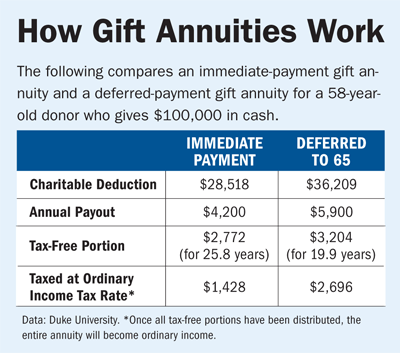Prepare to Retire With a Gift Annuity
Donors can make a charitable gift now but defer annuity payments to start years later.

Charitable gift annuities have long been a popular way for older retirees with philanthropic intent to create a lifetime income stream while getting a nice tax deduction. Today, a new twist on the gift annuity is attracting younger people who have yet to retire.
Most charitable gift annuities provide monthly payouts that start immediately after a donor makes the contribution. About 75% of donors who set up immediate annuities are older than age 75 when they make the gift, according to a 2013 survey of charities by the American Council on Gift Annuities.
Meanwhile, the council notes a growing interest in "deferred payment" annuities. A donor, say age 55, makes a gift but defers payment until a specific later date, perhaps five or ten years away. Half of these donors are 65 or younger. Charities are also offering "flexible start date" annuities, which allow donors to turn on payments at any time down the road.

Sign up for Kiplinger’s Free E-Newsletters
Profit and prosper with the best of expert advice on investing, taxes, retirement, personal finance and more - straight to your e-mail.
Profit and prosper with the best of expert advice - straight to your e-mail.
With all three approaches, you get a charitable tax deduction in the year you make the donation. Your deduction is based on how much leftover cash is expected to go to the charity after your death (or the death of your survivor if you choose a joint annuity).
Do Well by Doing Good
While older donors may be better off choosing a gift annuity that starts payments right away, workers who don't need the income now could consider the deferred or flexible options. "You may be still working, but you're thinking of retirement," says Jeremy Arkin, director of gift planning at Duke University. "You will know to the penny how much income you will get each year." (See the table.)
If you opt for the deferred or flexible annuity, you'll get a bigger payout the longer you postpone the income stream. That's partly because there will be fewer payments before you die.

Before you sign a contract, understand that you can't get the money back, says Bryan Clontz, president of consulting group Charitable Solutions. And if your only goal with an annuity is income and not philanthropy, you're better off buying a commercial annuity, which, Clontz says, offers payments that are about 50% higher than those offered by charities. (Most charities use payout rates set by the gift annuities council.)
The lower gift rates don't concern Steve Willey, 70, and his wife, Elizabeth, 67. They bought two commercial annuities soon after they sold their home solar-power business ten years ago. They started buying gift annuities as their bonds matured, and now they own nine of them. "The commercial annuities have a higher rate, but we realized that they were only benefiting the insurance company," Steve says.
The Willeys, who live in Sandpoint, Idaho, sank about $200,000 into the joint-life gift annuities and draw $16,000 in annual payouts—about 20% of their total income. They chose their favorite charities, including Greenpeace, the American Civil Liberties Union and a local animal shelter.
Steve Willey intends to buy more gift annuities, and he expects larger payouts. The older you are when you make the donation, the larger the annual payment and deduction. A 75-year-old who donates $100,000 would get a lifetime annual payment of $5,800 and a $45,772 deduction. That compares with a $28,518 deduction and $4,200 annual payment for a 58-year-old.
By using appreciated stock to fund your gift annuity, your deduction will be based on the current value of the shares. Part of each payment will be taxed as a long-term capital gain, part as ordinary income and part as a tax-free return of principal.
Time the charitable write-off "to minimize taxes in a big tax year," says Rick Rodgers, a financial planner in Lancaster, Pa. Also, because the annuity "becomes part of your fixed-income portfolio, you will need to adjust your asset allocation," he says.
Get Kiplinger Today newsletter — free
Profit and prosper with the best of Kiplinger's advice on investing, taxes, retirement, personal finance and much more. Delivered daily. Enter your email in the box and click Sign Me Up.

-
 Stock Market Today: Stocks Gain on Tech, Auto Tariff Talk
Stock Market Today: Stocks Gain on Tech, Auto Tariff TalkThe Trump administration said late Friday that it will temporarily halt tariffs on some Chinese tech imports.
By Karee Venema
-
 Sam's Club Plans Aggressive Expansion: Discover Its New Locations
Sam's Club Plans Aggressive Expansion: Discover Its New LocationsSam's Club expansion plans will open up to 15 new stores each year. Learn where they plan to open in 2025.
By Sean Jackson
-
 457 Plan Contribution Limits for 2025
457 Plan Contribution Limits for 2025Retirement plans There are higher 457 plan contribution limits for state and local government workers in 2025. That's good news for state and local government employees
By Kathryn Pomroy
-
 Medicare Basics: 11 Things You Need to Know
Medicare Basics: 11 Things You Need to KnowMedicare There's Medicare Part A, Part B, Part D, Medigap plans, Medicare Advantage plans and so on. We sort out the confusion about signing up for Medicare — and much more.
By Catherine Siskos
-
 The Seven Worst Assets to Leave Your Kids or Grandkids
The Seven Worst Assets to Leave Your Kids or Grandkidsinheritance Leaving these assets to your loved ones may be more trouble than it’s worth. Here's how to avoid adding to their grief after you're gone.
By David Rodeck
-
 SEP IRA Contribution Limits for 2025
SEP IRA Contribution Limits for 2025SEP IRA A good option for small business owners, SEP IRAs allow individual annual contributions of as much as $70,000 in 2025, up from $69,000 in 2024.
By Jackie Stewart
-
 Roth IRA Contribution Limits for 2025
Roth IRA Contribution Limits for 2025Roth IRAs Roth IRA contribution limits have gone up. Here's what you need to know.
By Jackie Stewart
-
 SIMPLE IRA Contribution Limits for 2025
SIMPLE IRA Contribution Limits for 2025simple IRA The SIMPLE IRA contribution limit increased by $500 for 2025. Workers at small businesses can contribute up to $16,500 or $20,000 if 50 or over and $21,750 if 60-63.
By Jackie Stewart
-
 457 Contribution Limits for 2024
457 Contribution Limits for 2024retirement plans State and local government workers can contribute more to their 457 plans in 2024 than in 2023.
By Jackie Stewart
-
 Roth 401(k) Contribution Limits for 2025
Roth 401(k) Contribution Limits for 2025retirement plans The Roth 401(k) contribution limit for 2025 increased, and workers who are 50 and older can save even more.
By Jackie Stewart